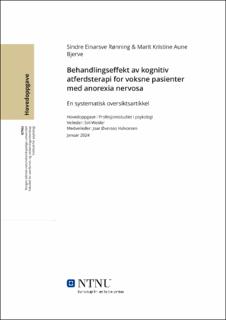| dc.contributor.advisor | Weider, Siri | |
| dc.contributor.advisor | Halvorsen, Joar Øveraas | |
| dc.contributor.author | Rønning, Sindre Einarsve | |
| dc.contributor.author | Bjerve, Marit Kristine Aune | |
| dc.date.accessioned | 2024-03-20T18:20:16Z | |
| dc.date.available | 2024-03-20T18:20:16Z | |
| dc.date.issued | 2024 | |
| dc.identifier | no.ntnu:inspera:155555788:15964788 | |
| dc.identifier.uri | https://hdl.handle.net/11250/3123487 | |
| dc.description.abstract | I denne systematiske oversiktsartikkelen har det blitt undersøkt behandlingseffekten av kognitiv atferdsterapi for voksne pasienter med anorexia nervosa, sammenlignet med en annen aktiv behandling. Det har blitt benyttet PICOS-rammeverket (Patient, Intervention, Comparison, Outcome, Study design), for å systematisere inklusjonskriteriene for denne studien. De inklusjonskriteriene som har blitt benyttet er blant annet at det skulle være voksne pasienter over 17 år med anorexia nervosa. Når det gjelder intervensjon har alle former for kognitiv atferdsterapi vært tillatt. Studier med en aktiv kontrollbetingelse har blitt inkludert og kroppsmasseindeks (Eng: Body Mass Index, BMI) har vært det primære utfallsmålet. Søkene som ble gjort i de ulike databasene resulterte i et treff på 1293 artikler, hvor 8 artikler kunne inkluderes basert på inklusjonskriteriene som var fastsatt. Alle studiene som ble inkludert i denne artikkelen viste at pasienter som mottok kognitiv atferdsterapi hadde en statistisk signifikant økning i vekt. Et gjennomgående funn var at gjennomsnittlig BMI, på gruppenivå, fortsatte å øke etter endt behandling, uavhengig av hvilken behandling man mottok. Vår studie finner ikke evidens for at kognitiv atferdsterapi har bedre behandlingseffekt enn andre aktive behandlingsbetingelser. | |
| dc.description.abstract | In this systematic review, the treatment effect of cognitive behavioral therapy for adult patients compared to another active treatment has been investigated. The PICOS framework which stands for Patient, Intervention, Comparison, Outcome and Study Design, has been used to systematize the inclusion criteria for this study. The inclusion criteria that have been used were that the included samples should consist of adult patients older than 17 years, diagnosed with anorexia nervosa. When it comes to intervention, all forms of cognitive behavioral therapy was included. Studies with an active control condition have been included and body mass index (BMI) has been the primary measure of outcome. The searches that were done in various databases resulted in 1293 articles, which resulted in a total of 8 articles that could be included based on the inclusion criteria (that had been set). The studies included in this article showed that patients who received cognitive behavioral therapy had a statistically increase in weight. A consistent finding was that the average BMI, at group level, continued to increase after the end of treatment, regardless of which treatment was received. Our study does not find evidence that cognitive behavioral therapy has a better treatment effect than other active treatment conditions. | |
| dc.language | nob | |
| dc.publisher | NTNU | |
| dc.title | Behandlingeffekt av kognitiv atferdsterapi for voksne pasienter med anorexia nervosa | |
| dc.type | Master thesis | |
